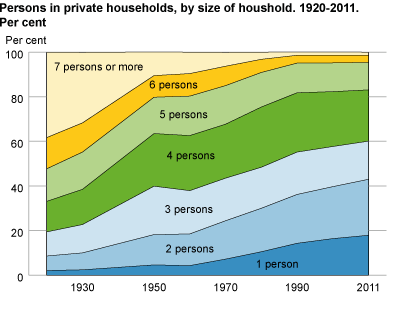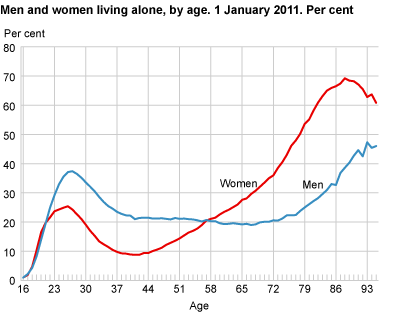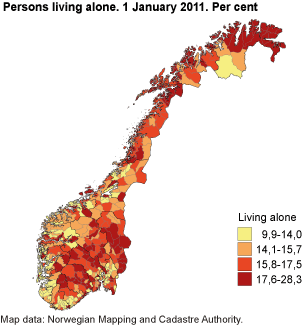Content
Published:
This is an archived release.
31 000 more households
The number of households increased by 31 000 in 2010. At present there are 2.2 million private households in Norway. Most people live in a household with 2 persons. It is also quite common to live alone.
There were 2.2 million households in Norway by the turn of the year. This is an increase of 31 000 households since 1 January 2010. The rise in the number of households is mainly due to an increase of 62 000 inhabitants in Norway in the same period of time. The average household size is 2.22 persons per household. In the Population and Housing Census in 1960 there was an average of 3.27 persons per household. Thus, there is now one person less in an average dwelling compared to 50 years ago.
Many people live alone
Most people, approximately one in four, live in a household with 2 persons. In 1960 it was most common to live in a household with four persons. In 1960 one out of four persons lived in a household with four persons. Today it is also quite common to live alone. Close to 20 per cent, or one in five persons now live alone. In 1960 only 4 per cent lived alone.
The percentage of people living alone has increased gradually over a very long period of time. In 1920, only 2 per cent, or one in fifty lived alone. At that time most people lived in large households. In 1920 more than half of the population lived in a household with 6 persons or more. Today only 5 per cent live in these kinds of households.
A household consists of all persons living in the same dwelling. Approximately four out of ten households are today composed of only one person. This means that there is only one person living in 40 per cent of the occupied dwellings in Norway.
The proportion that lives alone varies with age and sex
All in all, approximately the same percentage of men and women live alone. Twenty-three per cent of the men and 22 per cent of the women aged 16 years or more live alone. But the proportions living alone vary considerably between age groups and between men and women. Changes are largest in the lifecycle of women.
It is quite common to live alone when you are old, but also amongst the youngest you will find many people living alone. It is more common for young men to live alone than it is for young women. The proportion of women living alone is the lowest when they are about 40 years old; when less than 10 per cent of women in this age group live alone. Like young women, young men also live alone. However, the number of men living alone does not decrease with age to as low as that of women living alone. Roughly a fifth of the men live alone at the age of 40 and this proportion stays almost unchanged until the age of 75. The number of men living alone is partly explained by divorces. In a divorce, the children usually stay with the mother and the father lives alone, at least temporarily. As from 60 years of age it is more common for women than for men to live alone. One main reason for this is that women on average live longer than their generally older husbands and become widows.
Regional differences
It is most common to live alone in central urban municipalities and in remote inland areas in Southern Norway, as well as in Northern Norway. The highest proportion of persons living alone is found in Oslo, where 28 per cent live alone. Low percentages of persons living alone are found in the commuting areas around the largest cities and in coastal areas of Southern Norway.
|
The statistics are based on registers and legal residence address on 1 January 2011. This means that unmarried students registered at their parents' address are regarded as members of the household of their parents. Experience shows that statistics based on registers and legal residence address result in larger households, fewer one-person households and fewer cohabiting couples than statistics from surveys based on interviews and place of usual residence. The advantage of the kind of register statistics presented here is that they can be broken down into very precise geographical areas. |
Tables:
- Table 1 Population by, sex, age and type of household. 1 January 2011
- Table 2 Private households and persons per private household, by county. 1960, 1970, 1980, 1990, 2001 and 2011
- Table 3 Private households, by type of household. 1980, 1990, 2001 and 2011. Number and per cent
- Table 4 Private households and persons in private households, by size of household, county, municipality and urban district. 1. January 2011
- Table 5 Private households, by type of household, county, municipality and urban district. 1 January 2011
- Table 6 Private households, by type of household, county, municipality and urban district. 1 January 2011. Per cent
- Table 7 Private households and persons in private households, by type of household. 1 January 2011. Numbers and per cent
- Table 8 Persons in private households, by type of household, county, municipality and urban district. 1 January 2011. Per cent
- Table 9 Families in private households, by type of family, county, municipality and urban district. 1 January 2011
- Table 10 Families in private households with children 0-17 years by, county, type of family and number of children. 1 January 2011
- Table 11 Persons in private households, by sex, cohabitation arrangements and age. 1 January 2011
- Table 12 Couples and persons in couples with and without children in private households, by cohabitation arrangements, number of children in the family and age. 1 January 2011
- Table 13 Couples with and without children in private households, by cohabitation arrangements, county, municipality and urban district. 1 January 2011. Per cent
- Table 14 Persons 18 years and over in private households. Percentage living/not living as couples, by age, county, municipality and urban district.l. 1 January 2011. Per cent
- Table 15 Persons 67 years and over in private house holds, by age, sex and number of persons living in the household. County, municipality and urban district. 1 January 2011
Contact
-
Statistics Norway's Information Centre
E-mail: informasjon@ssb.no
tel.: (+47) 21 09 46 42
-
Espen Andersen
E-mail: espen.andersen@ssb.no
tel.: (+47) 92 61 00 46
-
Ane Margrete Tømmerås
E-mail: ane.tommeras@ssb.no
tel.: (+47) 91 99 29 62
-
Oppdrag befolkningsstatistikk
E-mail: befolkning@ssb.no



